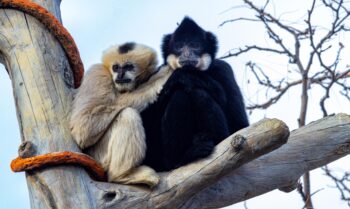February 10, 2020
Enrichment for Everyone
Learn About One of the Ways the Zoo’s Animal Care Team Ensures Our Animals’ Mental, Emotional and Physical Wellbeing
For us humans, enrichment might mean learning a new language, taking a trip to a far-flung destination, spending a day at your favorite zoo (wink, wink), or undertaking some self-improvement. Basically, it’s anything that improves our quality of life.
For the nearly 3,000 animals that call Denver Zoo home, the philosophy is the same, but the methods are different, and vary wildly from species to species. Behavioral enrichment is defined in technical terms as an animal husbandry principle that seeks to enhance the quality of animals under human care by identifying and providing the environmental stimuli necessary for optimal psychological and physiological well-being.[i] Simply put, it’s anything that improves their quality of life and gives each animal the opportunity to exercise their natural behaviors and adaptations.
Every living creature at the Zoo—from 11,500-pound Asian elephant, Groucho, in Toyota Elephant Passage, to our tiny, 170 gram tenrec Pixie, is encouraged to mimic their natural behaviors through carefully created enrichment plans. These include things like increasing feeding time with puzzle feeders or hidden food, tailoring habitats to stimulate exercise, or spraying various scents through a habitat to pique an animal’s curiosity and activity.
For our predators, feeding on large food items exercises jaw muscles, increases strength and extends foraging time. Natural feeding strategies are also encouraged and can help form bonds among our social carnivores, like African lions.
Pole feeding is one way we encourage natural behaviors, like jumping, with our two African lion prides. Here, Neliah and Kamara stretch their legs to get a tasty treat!
Our two Amur tigers, Nikita and Yuri, are often treated to scent enrichment at their home, The Edge. Keepers spray an array of different scents that encourage their natural hunting behaviors, including perfumes, spices, oils and even bedding used by other animals.
Nikita was paw-sitivley engaged with some perfume-scented hay. This activity encourages her to do exactly what she’d do in the wild—investigate new smells and hunt track down possible prey.
For many other animals, enrichment means providing objects that animals can explore, interact with in playful ways, or stimulate activity and provide exercise. You might see things like boomer balls, former beer kegs, puzzle feeders and other novelty items placed in habitats throughout the Zoo.
Keepers gifted Tundra with an oversized tractor tire that made its way through elephants and tigers—complete with all those interesting smells—and it was a total hit!
Join us for the wildest spring break in Colorado on March 14-April 5 as we showcase the many ways our world-class Animal Care team works to enhance the lives of our animals, highlighting how the enrichment items you see in our exhibits help to encourage natural behaviors. Keep an eye out on Facebook, Twitter and Instagram for more details coming soon!
[i] Shepherdson, D.J. (1998) “Tracing the path of environmental enrichment in zoos” in Shepherdson, D.J., Mellen, J.D. and Hutchins, M. (1998) Second Nature – Environmental Enrichment for Captive Animals, 1st Edition, Smithsonian Institution Press, London, UK, pp. 1–12.
Subscribe
Be among the first to hear the latest animal updates, important stories and details about all the fun happening around Denver Zoo.
Tags
-
 April 15, 2024
April 15, 2024Good Luck, Chuck!
Good Luck, Chuck! Beloved Bachelor Relocating as Part of Asian Elephant Species Survival Plan In a heartfelt and collaborative…
-
 April 15, 2024
April 15, 2024African Impact
African Impact Two New African Field Conservation ProgramsAim to Protect Gorillas + Grey Crowned Cranes We're honored to provide…
-
 March 1, 2024
March 1, 2024Last Place(s) on Earth
Last Place(s) on Earth New Asian Field Conservation Programs Protect Asian Elephants, Sumatran Orangutans + more Indonesia's Leuser Ecosystem…

